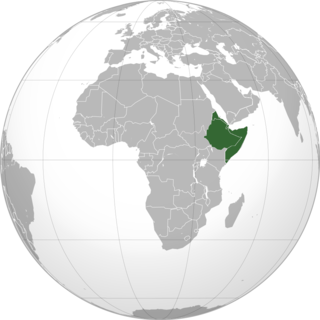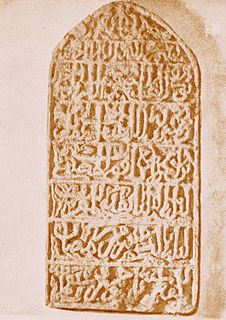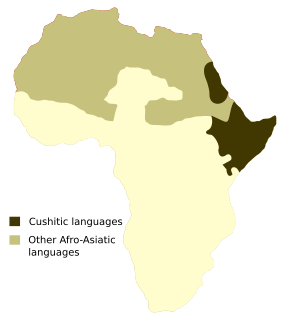
Somalia, officially the Federal Republic of Somalia (Somali: Jamhuuriyadda Federaalka Soomaaliya; Arabic: جمهورية الصومال الفيدرالية, translit. Jumhūrīyah aṣ-Ṣūmāl al-Fīdirālīyah, is a country located in the Horn of Africa. It is bordered by Ethiopia to the west, Djibouti to the northwest, the Gulf of Aden to the north, the Guardafui Channel and Somali Sea to the east, and Kenya to the southwest. Somalia has the longest coastline on Africa's mainland, and its terrain consists mainly of plateaus, plains and highlands. Climatically, hot conditions prevail year-round, with periodic monsoon winds and irregular rainfall.

Mogadishu, locally known as Xamar or Hamar, is the capital and most populous city of Somalia. Located in the coastal Banadir region on the Somali Sea, the city has served as an important port for millennia. As of 2017, it had a population of 2,425,000 residents. Mogadishu is the nearest foreign mainland city to Seychelles, at a distance of 835 mi (1,344 km) over the Somali Sea.

The Horn of Africa is a peninsula in Northeast Africa. It extends hundreds of kilometers into the Arabian Sea and lies along the southern side of the Gulf of Aden. The area is the easternmost projection of the African continent. Referred to in ancient and medieval times as the land of the Barbara and Habesha, the Horn of Africa denotes the region containing the countries of Djibouti, Eritrea, Ethiopia, and Somalia.

Somali is an Afroasiatic language belonging to the Cushitic branch. It is spoken as a mother tongue by Somalis in Greater Somalia and the Somali diaspora. Somali is an official language of Somalia, a national language in Djibouti, and a working language in the Somali Region of Ethiopia. It is used as an adoptive language by a few neighboring ethnic minority groups and individuals. The Somali language is written officially with the Latin alphabet.
The Rer Bare are a tribe in Ethiopia's eastern Ogaden region on the Shabele River, near Somalia, who currently speak Somali. They appear to have shifted to Somali from a now-extinct language.

The Somalis are an ethnic group belonging to the Cushitic peoples inhabiting the Horn of Africa. The overwhelming majority of Somalis speak the Somali language, which is part of the Cushitic branch of the Afroasiatic family. They are predominantly Sunni Muslim. Ethnic Somalis number around 28-30 million and are principally concentrated in Somalia, Ethiopia, Kenya, and Djibouti (534,000). Somali diasporas are also found in parts of the Middle East, North America, Western Europe, African Great Lakes region, Southern Africa and Oceania.
The Osmanya script, also known as Far Soomaali and, in Arabic, as al-kitābah al-ʿuthmānīyah, is a writing script created to transcribe the Somali language. It was invented between 1920 and 1922 by Osman Yusuf Kenadid, the son of Sultan Yusuf Ali Kenadid and brother of Sultan Ali Yusuf Kenadid of the Sultanate of Hobyo.

The demographics of Somalia encompass the demographic features of Somalia's inhabitants, including ethnicity, languages, population density, education level, health, economic status, religious affiliations and other aspects of the population.

This page articulates the languages spoken in Somalia. The official government website is available in three languages: Somali, English and Arabic.

The Borama alphabet or more generally known as the Gadabuursi script, is a writing script for the Somali language. It was devised around 1933 by Sheikh Abdurahman Sh. Nur of the Gadabuursi clan.

The Boni National Reserve is a national reserve for conservation and lies in the Garissa County, Kenya. The reserve covers an area of 1,339 km2 (517 sq mi) and is managed by Kenya Wildlife Service. It was gazetted in 1976 as a dry season sanctuary for elephants in the former Kenyan Ijara, and Lamu districts and Somalia. Unfortunately, elephant population has been greatly reduced by poaching.
Aweer (Aweera), also known as Boni, is a Cushitic language of Eastern Kenya. The Aweer people, known by the arguably derogatory exonym "Boni," are historically a hunter gatherer people, traditionally subsisting on hunting, gathering, and collecting honey. Their ancestral lands range along the Kenyan coast from the Lamu and Ijara Districts into Southern Somalia's Badaade District.
The Somali languages form a group that are part of the Afro-Asiatic language family. They are spoken as a mother tongue by ethnic Somalis in Horn of Africa and the Somali diaspora. Even with linguistic differences, Somalis collectively view themselves as speaking a common language.
Garre is an Afro-Asiatic language spoken by the Garre people inhabiting southern Somalia, Ethiopia and northern Kenya. It belongs to the family's Cushitic branch, and has an estimated 57,500 speakers. Garre has similarities with the Aweer language (Boni). However, its speakers are physically and culturally distinct from the Aweer people.
The Omo–Tana languages are a disputed branch of the Cushitic family and are spoken in Ethiopia, Djibouti, Somalia, and Kenya. The largest member is Somali. There is some debate as to whether the Omo–Tana languages form a single group, or whether they are individual branches of Lowland East Cushitic. Blench (2006) restricts the name to the Western Omo–Tana languages, and calls the others Macro-Somali.
The Aweer are an ethnic group inhabiting the Coast Province in southeastern Kenya. Some members are also found in southern Somalia. They are indigenous foragers, traditionally subsisting on hunting, gathering, and collecting honey.

Italian Somalis are Somali descendants from Italian colonists, as well as long-term Italian residents in Somalia.

The Kaddare alphabet is a writing script created to transcribe Somali, an Afro-Asiatic language.

A number of writing systems have been used over the years to transcribe the Somali language. Of these, the Somali Latin alphabet is the most widely used. It has been the official writing script in Somalia since the Supreme Revolutionary Council formally introduced it in October 1972, and was disseminated through a nationwide rural literacy campaign. Prior to the twentieth century, the Arabic script was used for writing Somali. An extensive literary and administrative corpus exists in Arabic script. It was the main script historically used by the various Somali Sultans to keep records. Writing systems developed locally in the twentieth century include the Osmanya, Borama and Kaddare scripts.











